Future Space
By Margot Douaihy
Walk into a company run by today’s digital natives and you may find a space characterized not only by its floor plan, but also by its adaptability. Think mobile devices everywhere, but no assigned desks; collaboration technology throughout. When people meet, it’s via video — and not just in dedicated executive suites, but everywhere. Some workers are collaborating in person; others are patching in from distant offices and interacting with the same content and tools.
Although this “agile office” is not yet mainstream, it’s on the horizon, due in part to the ubiquity and increasing usability of audiovisual (AV) solutions, such as videoconferencing and shared computing interfaces. A similar evolution is happening in classrooms, where learning spaces are being reimagined to foster better interaction and group work.
Technology is changing the way we think about work and life, which, in turn, impacts the places where we work and live. We’re on the cusp of dramatic change, and AV is playing a pivotal role.
Workspace Design: Ready for Anything
Corporations are the biggest purchasers of AV solutions. One important reason: Technology-equipped companies are better positioned to recruit and retain top talent. According to AVIXA’s Industry Outlook and Trends Analysis (IOTA) report, “a growing faction of corporate America is attempting to create more innovation by bringing employees back to home base. AV technology implementation is the way for companies striving to make the office ‘the place to be,’ in part by improving user experiences.”
Such environments can empower employees to work in ways that match their individual strengths. Technology-rich, multipurpose spaces can also breathe new life into stagnant practices and foster more efficient workflows.
With the growing demand for flexible AV in the workplace comes the need for flexible office designs. Research by design and architecture firm Gensler shows that “coworking has become an essential element to navigating constant change. In 2005, tech workplaces dedicated 89 percent of space to individual desks. Today it’s 25 percent, and by 2025, individual desks may not exist.”
These open, collaborative workspaces have their upside, but they also present challenges. A recent Harvard study found that open-plan offices can hurt productivity because workers feel they lack privacy — being able to hear everyone all the time tends to be either distracting or cause enough to stop talking altogether and actually decrease collaboration.
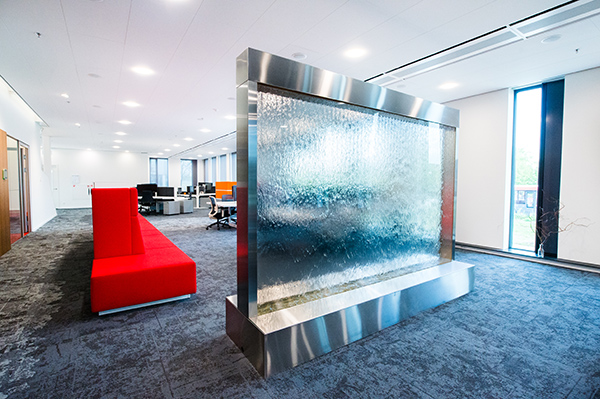
Plantronics Soundscaping
Audiovisual solutions can play a critical role turning the modern, open workspace into a productive space. AV ecosystems, such as Plantronics’ Habitat Soundscaping, combine audio and video components — as well as non-technical physical elements — to create offices that are more conducive to collaboration. Imagine video displays that appear to be windows or skylights, sounds of nature — specifically flowing water — playing through hidden speakers, and soothingly lit, modular waterfalls. Plantronics has reimagined its own Santa Cruz, Calif., offices with its technology to create an integrated experience. It’s not just the sound of water that employees find calming; actually seeing water — live or on-display — helps complete the cognitive circuit and creates a peaceful environment that reduces the distractions of an open office.
At other companies, the AV experience starts where people often get their first impression: the lobby. Lobby experiences can help energize employees and engage visitors. Take, for example, eBay’s Main Street location in Silicon Valley, created by ESI Design, built by AV integrator Diversified, and brought to life with content imagined by multimedia studio Float4.
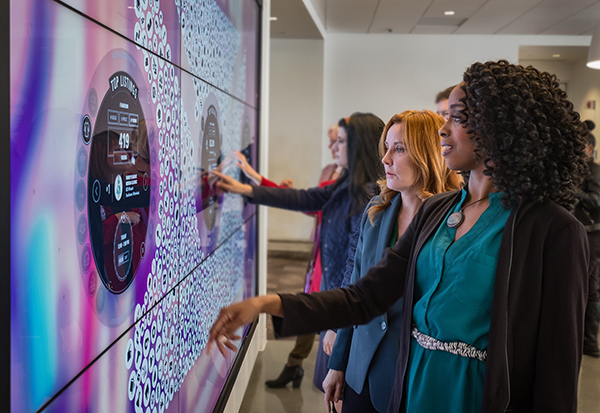 Upon entering the lobby, employees, partners, and visitors are immediately greeted by technology that tells the company’s story. Custom-fabricated
LED columns and interactive touchscreens display content that intermingles with the environment. The lobby’s centerpiece is a 15-foot videowall where employees and visitors can tap product icons to see how many sold recently on eBay.
Upon entering the lobby, employees, partners, and visitors are immediately greeted by technology that tells the company’s story. Custom-fabricated
LED columns and interactive touchscreens display content that intermingles with the environment. The lobby’s centerpiece is a 15-foot videowall where employees and visitors can tap product icons to see how many sold recently on eBay.
“Main Street has infused so much more energy and pride in our employee base,” said Wendy Jones, Senior Vice President of Global Operations at eBay.
Collaboration technologies, then, are the glue that holds together this energized, mobile, tech-savvy workforce. “Video-based collaboration will fuel improved connection and communication among employees in the workplace and remote colleagues, clients, and consultants,” says Craig Park, Principal Consultant at The Sextant Group.
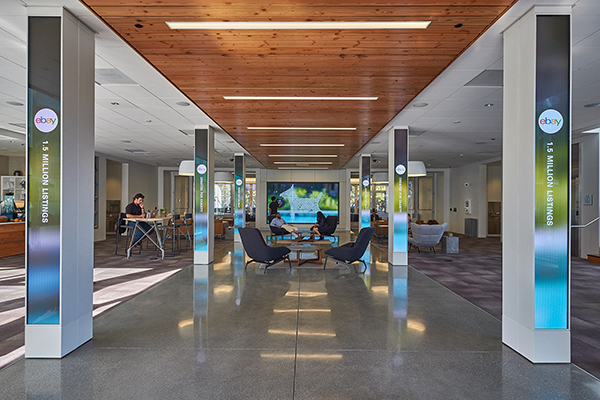 But for all the technical acumen of today’s workers, and their aversion to outdated business practices, collaborative audiovisual solutions
deployed in a modern office must be easy to use. There’s no time for onerous bug fixes or downtime. Employees already have many screens in their lives. They expect multi-screen, dynamic workspaces that they can enter instantly for visual immersion.
And the AV implemented today must be agile enough to support the next great killer app or workgroup paradigm, whatever it might be.
But for all the technical acumen of today’s workers, and their aversion to outdated business practices, collaborative audiovisual solutions
deployed in a modern office must be easy to use. There’s no time for onerous bug fixes or downtime. Employees already have many screens in their lives. They expect multi-screen, dynamic workspaces that they can enter instantly for visual immersion.
And the AV implemented today must be agile enough to support the next great killer app or workgroup paradigm, whatever it might be.
New York accounting firm CohnReznick built what it calls an "Innovation Lab” in its Manhattan office, giving clients the ability to brainstorm business solutions with CohnReznick staff quickly and efficiently through a combination of AV systems, proprietary software, and data. Software that lets users edit and manipulate documents, videos, graphics, and more on multiple displays, plus a matrix of large touchscreens, form the foundation. The space also includes cameras for videoconferencing and microphones embedded in the room’s ceiling to provide pickup coverage for all seats. The company put additional videowalls in its Chicago and New York City offices so remote participants could join sessions.
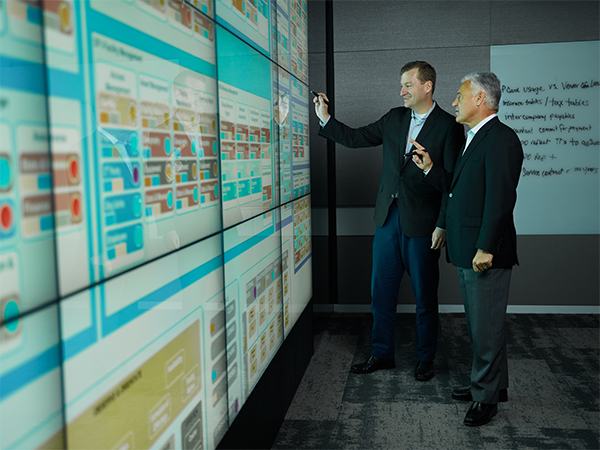 “Studies suggest that those organizations that successfully nurture an innovation culture realize increased profit compared to their peers.
Unfortunately, many growth companies lack the capability, including access to the latest tools and frameworks and the trained professionals to implement them, to create breakthrough growth,” says Keith Denham, Managing Principal and National
Director of CohnReznick Advisory. “We created the Innovation Lab to help clients build a renewed business culture that’s fast and nimble, seizing opportunities before the competition, to get ahead and stay there.”
“Studies suggest that those organizations that successfully nurture an innovation culture realize increased profit compared to their peers.
Unfortunately, many growth companies lack the capability, including access to the latest tools and frameworks and the trained professionals to implement them, to create breakthrough growth,” says Keith Denham, Managing Principal and National
Director of CohnReznick Advisory. “We created the Innovation Lab to help clients build a renewed business culture that’s fast and nimble, seizing opportunities before the competition, to get ahead and stay there.”
According to CohnReznick, its teams are now 60 percent faster at solving problems, and from an operations standpoint, they have become 45 percent more cost-efficient since implementing the Lab’s AV solution. And as good as the remote-collaboration capabilities have been, CohnReznick has found that design and strategy work is especially effective when participants are physically in the lab where they can interact with the AV collaboration tools.
“Because the workspace allows us to collaborate in real time with consultants and clients in different locations, our meetings not only have become more productive, but our team has become more aligned with clients,” says Paul Gulbin, Managing Director, CohnReznick Advisory.
The challenge in all this? Integrating AV and collaboration into workspaces so that users can be productive. “The standard worker wants to be able to use elevated technologies without extensive training,” say Shane Springer, CTS-I, an engineer and independent consultant. He’s noticed “a rise of more intelligent automation” and standards that can help employees move from room to room or system to system “without having to relearn the user interface.”
Creative Synthesis and the New Learning Space
Like the corporate campus, the college campus is ripe for innovation. From the AV clubs of yore to 4K displays in anatomy labs, audiovisual solutions and education are inextricable linked. Makerspaces, “sandboxes” with interactive displays, and interdisciplinary ideation spaces are becoming more common. But for Tim Van Woeart, Senior Project Supervisor for Digital Classroom Services at Rutgers University, active learning is still the dominant learning space trend.
Active-learning rooms can accommodate small groups, host break-out sessions, and support sharing ideas in multimodal, meaningful ways. Regardless of the wired or wireless audiovisual presentation systems, “everyone seems to be getting into the collaboration
dynamic now,” Van Woeart says.
Active learning means giving students more agency in the process. “It’s also meeting many of the students’ needs now that were not previously met,” Van Woeart says. “Some
students are learning better in smaller groups — at more of a personal and interactive level than in large lecture halls spaces.”
The Sextant Group’s Craig Park recognizes how active learning gives students more purchase, but he also says, “There are multiple pedagogical models that can be enhanced with AV.” When he consults with faculty, he discusses what teaching modality would be the best fit for their unique pedagogy, and then builds solutions around that modality.
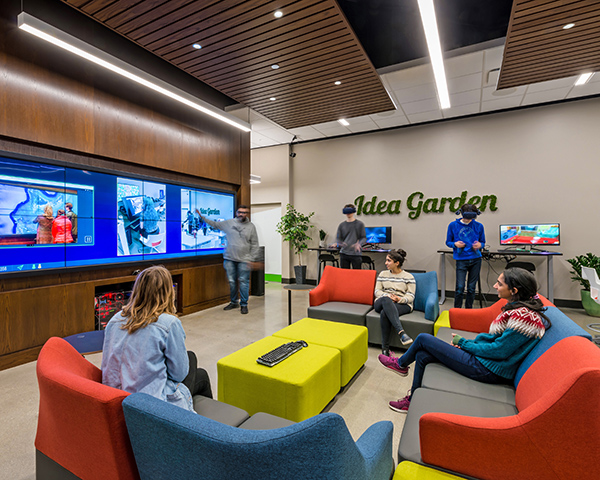 The Indiana University Idea Garden exemplifies the technology-rich “Thinker Space” — an environment designed to ignite student
curiosity and encourage cross-disciplinary practices. An energizing interior design and the latest collaborative technologies, such as the Google Jamboard and HTC Vive, help foster innovation.
The Indiana University Idea Garden exemplifies the technology-rich “Thinker Space” — an environment designed to ignite student
curiosity and encourage cross-disciplinary practices. An energizing interior design and the latest collaborative technologies, such as the Google Jamboard and HTC Vive, help foster innovation.
Virtual reality (VR) labs are also beginning to appear on campuses. At schools like William Paterson University in Wayne, N.J., VR labs are replacing obsolete spaces, such as photo development rooms. The debut recently of an affordable, wireless Oculus Quest VR system is being heralded as a disruptor that could help democratize the emerging technology.
“No longer do you have to go to a million-dollar space or CAVE to experience VR,” says Julie Johnston, Director of Learning Spaces for Indiana University’s Information Technology Services. As VR becomes more affordable and manageable, she says, “We need to consider putting it into our classrooms.”
The Indiana University Library Virtual and Augmented Reality Lab (VR/AR Lab) is available to all IU students, faculty, and staff. The real value of VR, as Johnston sees it, comes when the technology is embedded in a curriculum, encouraging students to think, learn, and solve problems in new and experiential ways.
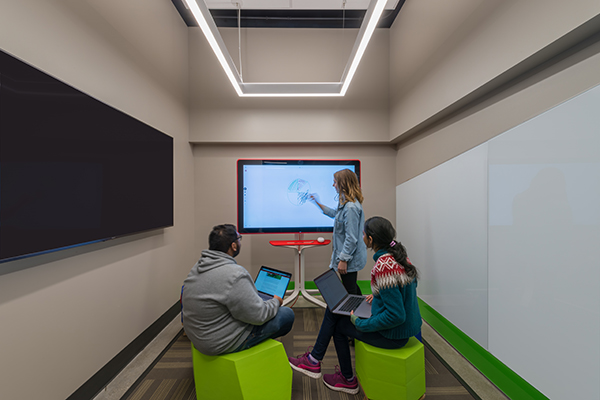 Video collaboration and online lecture capture technologies make classrooms more than a physical space in a building. Designed properly to maximize
acoustics, lighting, and sightlines, and integrated with the latest AV conferencing solutions, the campus space extends to rooms of students and lecturers all over the world.
Video collaboration and online lecture capture technologies make classrooms more than a physical space in a building. Designed properly to maximize
acoustics, lighting, and sightlines, and integrated with the latest AV conferencing solutions, the campus space extends to rooms of students and lecturers all over the world.
“We can do lot more with lecture capture,” says Van Woeart, “like bringing in professors who are experts in their field, outside of New Jersey.” He shares the example of a graduate-level sports management class in which the instructor, an Olympic gold medalist, taught from Jacksonville, Fla., for 95 percent of the class. “We virtually brought her into the classroom,” he says. “It was an immersive experience for the students, with live interaction.”
Whatever new technology impacts learning-space design, it must be tied to a genuine student need, says Justin Rexing, CTS-D, Audiovisual Design Engineer at Western Kentucky University and owner of the Rexing Consulting Group.
“We have to keep students’ perspectives in mind,” he says. This requires candid discussion, a needs analysis, and involving various stakeholders early in the process. Rexing believes “wise investments in audiovisual solutions can dramatically elevate the classroom experience.”
Engaging Experiences — in Public
And after a day of work or learning, people continue to move through spaces imbued with new audiovisual technology. Hospitality brands — hotels and restaurants — are adding AV to their designs to reflect the digital lifestyles of their guests and meet expectations for a technology-driven experience. Malls, transportation centers, public spaces — all are undergoing a digital evolution, integrating audiovisual solutions to create destinations.
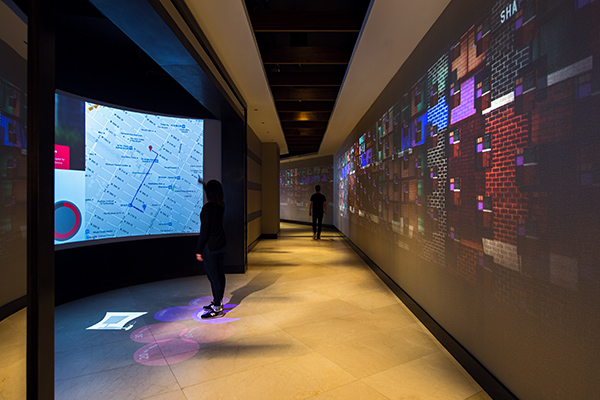 In the lobby of Marriott’s Renaissance New York Midtown Hotel, visitors
start their digital experience in the elevator corridor, where projected graphics react to their movements. As they walk through the lobby, wall content changes, inviting them to “play” with their surroundings. Farther down the corridor
is a virtual concierge, where guests can stand and point to projected images on the wall and explore what interests them. Sensors respond to people’s motions, activating content and helping determine where to go for dinner, take a walk, shop,
or experience the city’s culture.
In the lobby of Marriott’s Renaissance New York Midtown Hotel, visitors
start their digital experience in the elevator corridor, where projected graphics react to their movements. As they walk through the lobby, wall content changes, inviting them to “play” with their surroundings. Farther down the corridor
is a virtual concierge, where guests can stand and point to projected images on the wall and explore what interests them. Sensors respond to people’s motions, activating content and helping determine where to go for dinner, take a walk, shop,
or experience the city’s culture.
“It is an intricate dance between the brand’s expression in the physical environment and how interactive digital media plays a role in enhancing experiences,” says David Kepron, Marriott Vice President of Global Design Strategies.
At the new San Diego Intercontinental Hotel, guests and the public can enjoy Liquid Light, a projection-art installation displayed on a large glass façade. It’s a hyper-real, moving mural displayed in Ultra High Definition. “This project is a perfect example of how many in the hospitality industry are stepping up their game to create an extraordinary experience for guests,” says Jeff Irvin, Principal of Spinitar, the AV integrator that pulled the project together, along with technology manufacturer Christie Digital.
In Dubai, at the 680,000-square-foot City Walk mall, 100 million pixels of digital media and entertainment draw huge crowds to shop, watch multimedia shows, and simply enjoy themselves under a digital canopy, projection mapping and or surrounded by four moving projection-mapped water curtains.
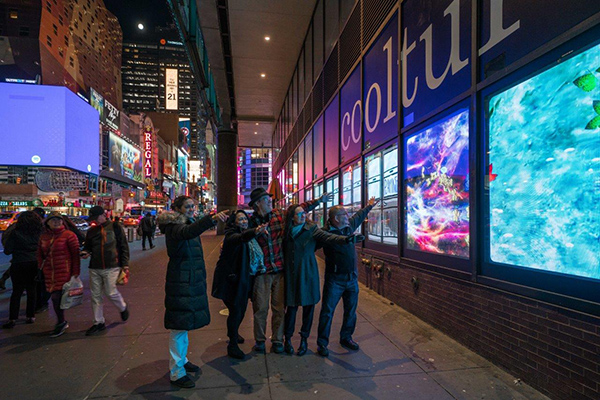 And then there’s public transportation. A frenetic hub of passenger activity, the Port Authority in Times Square, New York, is a gateway for
interstate traffic. Now it is also home to a clever installation of artful technology. Twelve ground-level windows of the Port Authority Bus Terminal have been transformed into Coolture Impact, a public, interactive videowall display composed of large
LED screens. The videowall includes a motion-sensor, camera-based tracking system that is custom-mounted along with the Leyard LED displays, offering passersby the chance to bring the digital canvases to life with their movements. It’s a place
where people can enjoy themselves before or after a long journey.
And then there’s public transportation. A frenetic hub of passenger activity, the Port Authority in Times Square, New York, is a gateway for
interstate traffic. Now it is also home to a clever installation of artful technology. Twelve ground-level windows of the Port Authority Bus Terminal have been transformed into Coolture Impact, a public, interactive videowall display composed of large
LED screens. The videowall includes a motion-sensor, camera-based tracking system that is custom-mounted along with the Leyard LED displays, offering passersby the chance to bring the digital canvases to life with their movements. It’s a place
where people can enjoy themselves before or after a long journey.
With advances in AV technology, virtually any type of space can be transformed to create new experiences and facilitate better productivity, learning, enjoyment, and more. “We continue to study audiovisual experiences, such as digitally immersive environments, adaptive interfaces and the neuroscience of customer engagement in a digital world,” says Marriott’s David Kepron. “The influence of a digitally-mediated culture on an emerging generation will result in vastly different expectations.”
Dan Daley and Kirsten Nelson contributed to this story.





